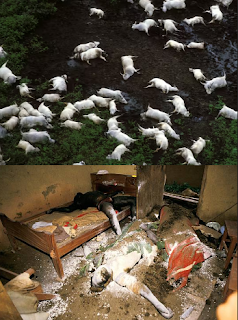How A Silent Natural Disaster Nearly Wiped Out A Whole Village And Their Livestock
 |
| 3500 livestock were killed |
 |
| The blue lake turned into rusty brown color |
How A Silent Natural Disaster Nearly Wiped Out A Whole Village And Their Livestock
1,746 people and 3,500 animals perished on August 21, 1986, in northwest Cameroon from a strange event called limnic eruption.
Before the disaster, Lake Nyos had been quiet for a long time. Cameroon is a country in West Africa. Farmers and herders who moved around knew the lake was big, still, and blue.
The eruption caused the sudden release of hundreds of tons of carbon dioxide that suffocated humans and livestock.
The Deadly Eruption From The Lake
It is unknown what caused the severe outgassing. Most geologists assume a landslide happened, however some believe a tiny volcanic explosion occurred on the lake's bed.
A third explanation is that the overturn was caused by cool rains falling on one side of the lake. Others believe there was a minor earthquake, but given witnesses reported no shakes on the morning of the accident, this theory is doubtful.
The incident caused supersaturated deep water to rapidly mix with the lake's upper layers, where the lower pressure allowed the stored CO2 to effervesce out of solution.
By August 23, most of the cloud had moved away, and the silence was gone. Some people woke up after being unconscious for up to 36 hours to find that their family, neighbors, and animals had all died.
Also, the lake had changed. It was now shallower, plants and leaves floated in it, and the once-beautiful blue color had changed to a rusty brown.
Scientists thought that the 682 feet of water at the bottom of Lake Nyos had kept CO2 there for a long time. On the day of the eruption, however, the gas came out because of something outside the volcano.
It was probably a rockslide from one of the lake's walls. When the rocks fell into the lake and sank to the bottom, they pushed up some gas. Then most of the gas came to the surface, and travelled down the nearby villages.
Because carbon dioxide has a density 1.5 times that of air, the cloud embraced the ground and traveled down valleys where there were many villages. The mass was around 50 meters thick and moved downward at a rate of 20-50 kilometers per hour.
The gas cloud was dense enough to smother several people while they slept.
Many people were able to flee before the attack had a grip on their lives. They survivors reportedly experienced respiratory issues, and paralysis.
They also reported a gunpowder or rotten egg odor, indicating that sulfur dioxide and hydrogen sulfide quantities were over their odor thresholds.
However, CO2 was the only gas detected in the lake water tests that were conducted after the disaster, indicating that it was the principal gas produced and thus the primary cause of the disaster.
CO2 can cause sensory hallucinations, such that many people exposed to CO2 report the odor of sulfuric gas and others even when none are present.
A pictorial explanation of the disaster
Some things about limnologically active lakes are:
CO2-saturated incoming water
An upper and lower thermal layer with differing CO2 saturations
Proximity to areas with volcanic activity
Lake Monoun
On August 15, 1984, there was a limnic eruption at the lake. This caused a lot of carbon dioxide (CO2) to be released, which killed 37 people.
At first, no one knew what caused the deaths, and things like terrorism were thought to be a possibility. The current explanation is based on more research and a similar event that happened at Lake Nyos two years after the first one.
Aside from the unfortunate death from limnic eruption as shown the post, thousands of people have also died from carbon monoxide poisoning in their sleep.
References, and Further Reading:
How did Lake Nyos suddenly kill 1,700 people?
Cameroon’s ‘exploding’ lakes: disaster expert warns deadly gas release could cause another tragedy
112 lake nyos cameroon stock photos



.jpg)

.jpeg)






Comments
Post a Comment